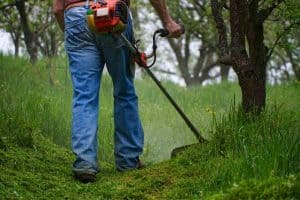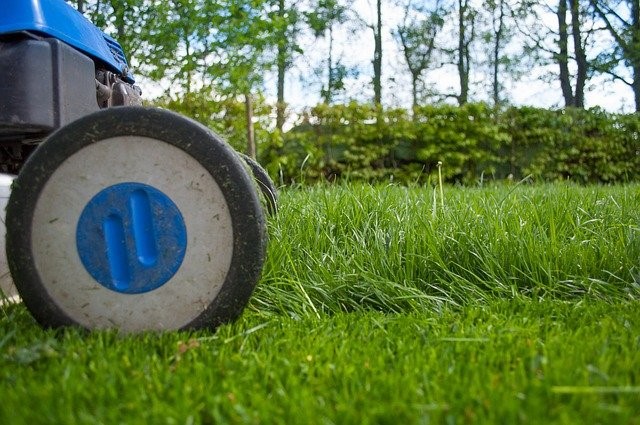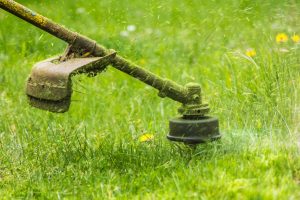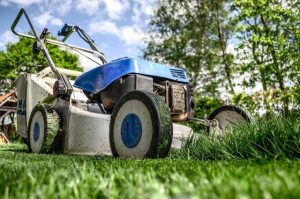
When to Mow Your New Lawn
We are reader supported, and may earn commissions from links on this page.
Mowing your lawn is an essential component to keep your lawn green, thick, and healthy. Whether your lawn has been growing from being planted as seedlings or you have had new turf laid, will determine when the best time is to mow your lawn. In this article we discuss the optimal mowing time for your new lawn for both grass that has grown from seedlings and newly laid turf.

Table of Contents
When to mow your lawn when you have planted seeds
Let your new lawn establish its roots
Seeded lawns have the longest period between planting your grass and mowing. It could take up to two months. This is because you have to wait for the seeds to germinate before you can cut the grass. The grass could grow up to 3.5 inches in height after eight weeks if you planted it during its active growing season.
How often to mow your lawn
Before mowing your seeded lawns, ensure that it is fairly dry to avoid pulling it out. As a rule of thumb, you should allow your lawn to grow about one and a half times the recommended height before cutting. Set your mower blade to the recommended cutting height for your lawn species. When mowing your lawn the first time, let your lawn grow a little higher from the recommended range before cutting it to give it a little more time to become established. Ensure that you cut off a third of the blade. Mow again after a few days later and cut the grass following the recommended height. Then mow regularly to keep your lawn healthy.
When to mow your freshly laid turf
Best time frame to let your new lawn establish
A freshly laid turf has a shorter timeframe between laying the turf and mowing it compared to seeded lawns. It can take about a couple of weeks or more before you can mow it for the first time. To check if it’s ready, you can try to lift the edge of the turf. If it lifts easily, it’s best to wait for a few more days. But if the turf is already established the next thing to check is if it has grown about 6 cm in height. Remember that you should never mow more than a third of the leaf.
How often to mow your newly laid turf
The first cut happens when the freshly laid turf is firmly rooted in the soil and has grown to a height of about 6 cm. Avoid letting it grow higher more than this for the first mowing. The subsequent mowing should not be done below 4 cm especially when the turf is still establishing.

Garden landscaping tips to care for your lawn
1. Mow your lawn regularly
Mowing your lawn weekly is the common maintenance advice given by garden landscapers. Some lawns may need cutting more often. However, other species of lawn will grow slowly and may only need cutting once every two weeks. As a general rule, do not cut off more than one-third of the grass blade to avoid harming the grass.
2. Water your lawn
Watering grass seedlings is done every morning and in the evening. You would want to water them while the weather is still cool ideally between 6 – 10 am. Gradually increase your morning watering sessions overtime while decreasing your evening watering sessions. Your lawn will typically need about an inch of water per week this amount also includes rainfall.
A freshly laid turf, once established, would only require watering when necessary. Freshly laid turf, once established will require one deep watering per week which is about 25 mm. This will help the turf to be more drought tolerant. You may need more watering for sandy soils.
To check if your watering is sufficient, you can place a container on the lawn when watering. Take note of the time and how long it takes for the container to meet the suggested watering requirements for your lawn. This will allow you to have an idea of how to water your lawn properly in the succeeding watering sessions.
3. Weed care for your lawn
Taking care of weeds on your lawn starts with creating an environment to prevent weeds from thriving. How do you do this? Common practice in weed prevention by landscapers is to us a pre-emergent herbicide to kill weeds before they even start growing. Factors like mowing grass low, less watering, or compacted soil promote the growth of weeds.
When weeds have started to grow, you can use post-emergent herbicides to stop further growth and eradicate the weeds. Be mindful of the recommended personal protective equipment when using the herbicides. Alternatively, there are natural remedies for weed control such as applying a vinegar spray to the lawn, this is effective when the weed growth is yet widespread.
Final Words
Lawn care is essential to keep your grass healthy and thriving in your yard. Regular lawn maintenance can be a bit difficult task to fit into your busy schedule.
But you can always hire a landscaper to look after your lawn and keep your lawn healthy and looking great without even breaking a sweat!
Welcome

Howdy, I’m Matt and welcome to my site Mowing With Matt. I’ve always been a self confessed lawn mowing nut and have learnt plenty about looking after lawns.
I’d like to share this knowledge by providing valuable information and tips from buying the right lawn mower to keeping your grass green.
Looking for something specific?
J.Bruce
Professional landscaper and lawn care specialist. Find out more about our garden landscaping and lawn care services at https://ausgarden.com.au/garden-landscaping/



